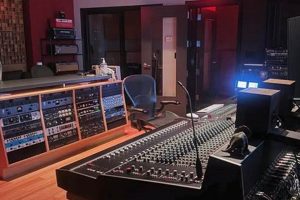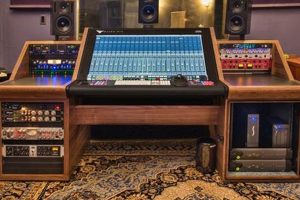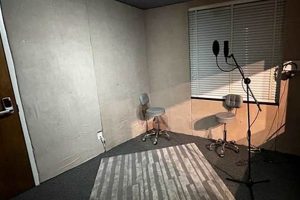Devices designed to capture audio signals with high fidelity in a controlled acoustic environment form an integral part of professional audio engineering. These transducers convert sound waves into electrical signals suitable for recording, processing, and reproduction. Examples include condenser, dynamic, and ribbon types, each exhibiting unique characteristics in terms of sensitivity, frequency response, and transient response.
The employment of these specialized instruments is crucial for achieving optimal sound quality in music production, voice-over work, and other audio-related fields. Their selection significantly impacts the overall sonic character of a recording. Historically, advancements in this technology have paralleled the evolution of recording techniques, influencing artistic expression and shaping the soundscapes of popular culture.
The subsequent sections will delve into specific models, polar patterns, and technical specifications, providing a detailed examination of the tools essential for creating professional-grade audio recordings. This exploration will further illuminate considerations for choosing the appropriate equipment for various recording scenarios.
Essential Usage Considerations
Proper selection and application are paramount for achieving optimal results. Awareness of technical specifications and acoustic principles is critical for sound recording practices.
Tip 1: Polar Pattern Selection: Choose the appropriate directional characteristic based on the source and environment. Cardioid patterns reject sound from the rear, useful in live settings. Omnidirectional patterns capture sound from all directions, ideal for capturing room ambience.
Tip 2: Proximity Effect Management: Understand the increase in low frequencies as the source nears the diaphragm. Adjust positioning or employ a high-pass filter to mitigate excessive bass response.
Tip 3: Gain Staging Optimization: Set input levels carefully to maximize signal-to-noise ratio. Avoid clipping by ensuring that peak signals do not exceed the available headroom.
Tip 4: Shock Mount Implementation: Utilize a suspension system to isolate from vibrations and handling noise. This practice minimizes unwanted low-frequency rumble in recordings.
Tip 5: Pop Filter Integration: Position a screen between the sound source and the diaphragm to reduce plosive sounds. This prevents bursts of air from overloading the capsule.
Tip 6: Regular Maintenance Practices: Clean elements according to manufacturer instructions. Proper care ensures longevity and consistent performance of these instruments.
Tip 7: Experimentation and Critical Listening: Conduct aural tests with different models and placement techniques. Develop an ear for identifying subtle nuances in sound capture.
Mastering these techniques enhances the accuracy and clarity of audio recordings. Attention to detail in these practices yields superior sonic outcomes.
The subsequent section will provide a comparison of available models, furthering the understanding of this technology.
1. Transducer Technology
The core mechanism by which sound pressure waves are converted into electrical signals defines a vital characteristic. The selection of transducer type directly impacts the sonic attributes and performance capabilities within a recording environment.
- Condenser Microphones
Employ a capacitor to detect sound pressure variations. A thin diaphragm, acting as one plate of the capacitor, vibrates in response to incoming sound waves, altering the capacitance. This change is then converted into an electrical signal. Condenser designs generally exhibit higher sensitivity and a wider frequency response compared to dynamic types, making them suitable for capturing subtle details and complex harmonic structures. They necessitate external power, typically phantom power (+48V), for operation. Their sensitivity can also make them more susceptible to overload with very loud sources.
- Dynamic Microphones
Utilize electromagnetic induction. A diaphragm is connected to a coil of wire suspended within a magnetic field. As the diaphragm vibrates in response to sound, the coil moves within the magnetic field, inducing a voltage proportional to the sound pressure. Dynamic types are typically more robust and less sensitive than condenser versions. They are well-suited for high sound pressure levels, such as those encountered with drums or amplified instruments. Their lower sensitivity also makes them less prone to feedback in live settings.
- Ribbon Microphones
A specialized type of dynamic, featuring a thin, corrugated metal ribbon suspended within a magnetic field. Sound pressure causes the ribbon to vibrate, generating an electrical signal. Ribbon microphones are known for their warm, smooth sound character and their characteristic figure-eight polar pattern. While once fragile, modern ribbon models are more durable. They are frequently employed on vocals, horns, and guitar amplifiers to impart a vintage sonic quality. Some ribbon types may require careful impedance matching with preamplifiers.
- MEMS Microphones
Micro-Electro-Mechanical Systems microphones are miniaturized, using a silicon diaphragm etched onto a chip. Their compact size is well-suited to mobile recording devices, however, generally do not possess the sonic qualities of larger microphones. The application of MEMS to studio-grade recording is a growing field. Though limited bandwidth, the reduction in overall size of the microphone is extremely useful for various applications such as broadcast, conference or field recording where space is a premium.
The choice of the correct technology depends entirely on the application, instrument and environment to be recorded, along with an understanding of the sonic character that the engineer wishes to apply. As recording technology has advanced the options of transducer technology have broadened to meet the various requirements.
2. Polar Response
Polar response, also known as directionality, fundamentally defines a crucial characteristic of recording studio microphones: its sensitivity to sound arriving from different angles relative to its central axis. This directionality plays a pivotal role in capturing sound sources with precision, minimizing unwanted ambient noise, and shaping the overall sonic texture of a recording. A microphone’s polar pattern directly impacts the ratio of direct sound to reflected sound captured, influencing the perceived proximity, ambience, and clarity of the recorded audio. For instance, a cardioid pattern, commonly used for vocals, exhibits maximum sensitivity to sound arriving from the front and rejects sound from the rear, thus minimizing room reflections and background noise. Conversely, an omnidirectional pattern captures sound equally from all directions, providing a more natural, spacious sound that includes room ambience.
The selection of an appropriate polar pattern is dictated by the specific recording application and acoustic environment. In situations where isolation is paramount, such as recording multiple instruments simultaneously in a single room, microphones with tight polar patterns like hypercardioid or figure-eight are employed to minimize bleed-through from adjacent sound sources. Conversely, for capturing the overall sound of a drum kit or a choir, omnidirectional or wide cardioid patterns are often preferred. Furthermore, certain advanced recording techniques, such as mid-side (M-S) stereo recording, rely on specific polar pattern combinations (cardioid and figure-eight) to create a wide, adjustable stereo image. The inherent characteristics of different polar patterns allow recording engineers to sculpt the sound field, emphasizing desired elements while attenuating unwanted ones.
In summary, polar response is not merely a technical specification but a critical parameter that shapes the sonic fingerprint of a recording. Understanding and manipulating polar patterns empowers recording engineers to exercise control over the spatial aspects of sound capture, achieving greater clarity, isolation, or ambience as dictated by artistic intent. The challenges associated with selecting the appropriate polar pattern involve a deep understanding of microphone characteristics, acoustics, and desired sonic outcomes, ultimately contributing to the realization of professional-grade audio productions.
3. Frequency Response
Frequency response is a fundamental attribute of recording studio microphones, defining its ability to accurately capture and reproduce the spectrum of audible frequencies. This specification indicates the microphone’s sensitivity to various frequencies, influencing the tonal balance and overall fidelity of the recorded sound.
- Definition and Representation
Frequency response is typically depicted graphically as a curve showing the microphone’s output level (in decibels) across the audible frequency range (typically 20 Hz to 20 kHz). An ideal microphone would exhibit a flat frequency response, indicating equal sensitivity to all frequencies. However, in practice, microphones exhibit variations in their response, with peaks or dips at certain frequencies. These variations contribute to the microphone’s unique sonic character.
- Impact on Sound Quality
The frequency response of a microphone directly affects the perceived timbre of the recorded sound. A microphone with a pronounced peak in the high frequencies may sound bright and airy, while one with a boosted low-frequency response may sound warm and full. Understanding a microphone’s frequency response is crucial for selecting the appropriate tool for a given sound source. For instance, a microphone with a tailored frequency response for vocals may enhance clarity and presence, while one designed for instruments may accurately capture the instrument’s natural sound.
- Types of Frequency Response Characteristics
Microphones can exhibit various frequency response characteristics, including flat, rising, falling, and tailored responses. A flat response is desirable for accurate reproduction of the source material. A rising response emphasizes high frequencies, often used to add clarity to dull or muddy sources. A falling response attenuates high frequencies, useful for taming harsh or sibilant sounds. Tailored responses are designed for specific applications, such as vocal recording or instrument amplification, often with targeted boosts or cuts in certain frequency ranges.
- Considerations for Selection
When selecting microphones for a recording studio, frequency response should be considered in conjunction with other factors such as polar pattern, sensitivity, and noise floor. The ideal frequency response depends on the intended application and desired sonic characteristics. Experimentation with different microphones on various sound sources is essential for determining the best tool for each scenario. While specifications like “flat response” can be valuable, it is common that coloration is a desired, if not required, element of some recording practices.
In conclusion, frequency response is a critical parameter that shapes the sonic character of recording studio microphones. Understanding and interpreting frequency response specifications empowers recording engineers to make informed decisions, ultimately contributing to the creation of high-quality audio recordings.
4. Sensitivity Rating
Sensitivity rating, expressed in millivolts per Pascal (mV/Pa) or decibels relative to 1 V/Pa (dBV/Pa), denotes the output level of a microphone for a given sound pressure input. This specification is a critical parameter in recording studio microphones, as it directly impacts the signal-to-noise ratio and preamplifier gain requirements. A higher sensitivity rating indicates a stronger output signal for a specific sound pressure level, reducing the need for substantial preamplification. Conversely, a lower sensitivity rating necessitates greater gain from the preamplifier to achieve a usable signal level. An inadequate sensitivity for an instrument or environment will dramatically impact the performance and sonic qualities achieved.
The interaction between sensitivity rating and preamplifier gain is crucial to the overall quality of a recording. Insufficient gain can result in a noisy signal dominated by the preamplifier’s inherent noise floor. Excessive gain, on the other hand, can overload the preamplifier, leading to distortion and clipping. Choosing a microphone with an appropriate sensitivity rating, therefore, is essential for optimizing the gain staging process. For example, recording quiet sources such as acoustic guitars or vocals with subtle dynamics benefits from microphones with high sensitivity. Conversely, recording loud sources such as drums or electric guitar amplifiers may necessitate microphones with lower sensitivity to prevent clipping, irrespective of preamplifier gain settings. Dynamic microphones, for instance, often have lower sensitivity ratings than condenser types, making them suitable for handling high sound pressure levels.
In conclusion, sensitivity rating is a key determinant in the performance of recording studio microphones. It influences the choice of microphone for specific recording scenarios, dictates preamplifier gain settings, and affects the overall signal-to-noise ratio. A thorough understanding of sensitivity rating empowers recording engineers to select and utilize microphones effectively, ensuring clean, clear, and professional-sounding recordings. Careful attention to this specification, alongside other microphone characteristics, is paramount for achieving optimal audio capture in diverse recording environments.
5. Noise Floor
The noise floor represents the inherent level of background noise produced by the microphone itself, independent of external sound sources. This electrical self-noise, typically quantified in dBA-weighted SPL, arises from thermal agitation within the microphone’s internal circuitry. A lower noise floor is fundamentally desirable as it allows for the capture of quieter sound sources with greater clarity and dynamic range. High-end recording studio microphones are meticulously designed to minimize this inherent noise, employing premium components and sophisticated circuitry. The presence of a discernible noise floor can mask subtle nuances in recordings, particularly when capturing delicate sounds like acoustic instruments or soft vocals. For instance, a microphone with a high noise floor might render the quiet decay of a piano note inaudible, or obscure the breath sounds in a vocal performance.
The impact of the noise floor is magnified when using high gain settings on preamplifiers. To compensate for the low output of a quiet sound source or a low-sensitivity microphone, the preamplifier amplifies not only the desired signal but also the microphone’s self-noise. Therefore, a microphone with a low noise floor becomes particularly crucial in situations where significant gain is required. Dynamic microphones, while robust and capable of handling high SPLs, often exhibit lower sensitivity compared to condenser microphones, necessitating higher gain settings and thereby potentially amplifying their self-noise. Similarly, vintage ribbon microphones, prized for their unique tonal characteristics, can also possess relatively high noise floors, requiring careful preamplifier selection and gain staging.
In summary, the noise floor is a critical performance parameter of recording studio microphones. Its impact is particularly evident when capturing quiet sources or using high preamplifier gain. A lower noise floor translates to a cleaner, more detailed recording, allowing for a wider dynamic range and more accurate sonic representation. While not the only factor to consider, a low noise floor is a hallmark of professional-grade microphones and contributes significantly to the overall quality of audio productions. Understanding and mitigating the effects of noise floor remains a significant challenge for recording engineers, demanding careful equipment selection and optimized recording techniques.
Frequently Asked Questions
The following section addresses common inquiries regarding the selection, application, and maintenance of sound capture devices within professional audio environments.
Question 1: What distinguishes condenser types from dynamic types?
Condenser types employ a capacitor to transduce sound, exhibiting greater sensitivity and wider frequency response. Dynamic types utilize electromagnetic induction, offering robustness and suitability for high sound pressure levels.
Question 2: How does polar pattern selection impact recording quality?
Polar pattern determines the microphone’s directional sensitivity. Cardioid patterns reject rear-incident sound, minimizing room reflections. Omnidirectional patterns capture sound equally from all directions, including ambient information.
Question 3: What is the significance of a microphone’s frequency response?
Frequency response defines the microphone’s ability to capture and reproduce the spectrum of audible frequencies accurately. Flat frequency responses are desired for faithful reproduction, while tailored responses emphasize or attenuate specific frequency ranges.
Question 4: How does sensitivity rating influence preamplifier gain settings?
Sensitivity rating indicates the microphone’s output level for a given sound pressure input. Higher sensitivity reduces the need for excessive preamplifier gain, minimizing noise and potential distortion.
Question 5: What constitutes an acceptable noise floor for studio recording?
Lower noise floors are generally preferred, enabling the capture of quieter sound sources with greater clarity and dynamic range. Professional-grade microphones typically exhibit noise floors below 15 dBA SPL.
Question 6: How frequently should studio microphones undergo maintenance?
Maintenance frequency depends on usage and environmental conditions. Regular cleaning of the capsule and inspection of cables are recommended. Calibration should be performed periodically to ensure accurate performance.
Proper understanding of these factors contributes to optimal recording practices. Consult manufacturer specifications for detailed technical information.
The subsequent section will explore advanced recording techniques employing specialized microphone configurations.
Conclusion
The preceding examination has detailed the multifaceted nature of recording studio microphones, encompassing transducer technologies, polar patterns, frequency response characteristics, sensitivity ratings, and noise floor considerations. These parameters collectively determine the suitability of a particular device for specific recording applications. Careful selection and proper utilization are essential for achieving optimal sonic fidelity within a controlled acoustic environment.
As audio engineering continues to evolve, ongoing research and development will inevitably yield further advancements in microphone technology. A thorough understanding of the principles outlined herein will enable audio professionals to adapt to these innovations and leverage them to create increasingly nuanced and compelling recordings. Continued vigilance in equipment maintenance and critical listening practices remains paramount for maximizing the performance and longevity of these indispensable tools.







